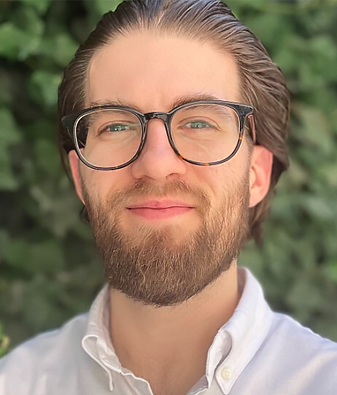← Back to 2024 December Roundup Newsletter Contents
Chris Miller is a sociologist of religion and this year’s Jackman Humanities Institute-Critical Digital Humanities Initiative (JHI-CDHI) Digital Humanities Fellow. His postdoctoral fellowship project examines the increasing popularity of “green burial” — an umbrella term used to describe the growing list of alternatives to traditional disposition services. Miller is working on his project with supervisor Pamela Klassen, the Department for the Study of Religion Chair and Graduate Chair,
A new way to say goodbye: Inside the growing popularity of green burial
The novelist Haruki Murakami once observed that death was not the opposite of life, but a part of it.
And yet, important though it is, death remains a frightening topic that many of us would rather not discuss. This is why a small but growing group around the world is trying to start a much-needed conversation about how societies should approach death in the 21st century — which includes new ideas about how to dispose of our bodies after we die.
“Many people want to use methods that respect their bodies, but also respect the environment,” says Chris Miller.

Such methods may include natural or forest burial, where the body is placed directly in the ground in a simple pine box or shroud; aquamation, where a combination of gentle water flow, temperature, and alkalinity are used to accelerate the breakdown of organic materials, thereby avoiding the toxic burning practices of cremation; or terramation — also known as human composting — in which the body is encased in a combination of wood chips and straw, thereby accelerating decomposition. Not all services are currently legal in every Canadian jurisdiction, but all are gaining traction.
People choose green burial for a variety of reasons. These range from the high cost associated with traditional burials, to religious restrictions placed on services, to the necessary removal of medical devices that can interfere with cremation.
But by far the biggest reason for green burial is contained within its name: responsibility to the environment.
“When you get buried in a coffin, the lacquered wood takes years to decompose,” Miller says. “Embalming fluid is toxic to the soil, and cremation has a carbon footprint equivalent to a very long car ride. People who seek green burial believe they’ve hurt the earth enough while alive, and would rather not do it after death. It’s also a way of getting back in touch with nature.”
In a green burial, interment in a simple shroud or box hastens one’s eventual communion with the earth. Burials often take place within dedicated cemeteries, or parts of regular cemeteries earmarked for such services. Instead of large gravestones, they can feature communal signs indicating the names of people buried there. Burial sites may also be indicated by flowers, stones or geotags.
Right now, Miller is preparing to embark on a year of intense research. “I’m hoping to go across the country. British Columbia is a particularly big centre for green burial,” he says. “I’ll want to walk around and explore the sites, asking: what do they look like, how are they different? I also want to see how death and nature exist side by side, and to talk to people involved in this movement — heads of organizations, politicians and families.”
One question he’d like to ask is, does the way in which we bury someone shape our understanding of an afterlife?
“Energy is a powerful word in this movement,” he affirms. “A body’s atoms break down, which are eventually going to give energy to other things and feed off other forms of life. The idea behind this is: I want my energy to go on, and to do positive things.”
Each year, the Jackman Humanities Institute selects an annual theme, allowing members of its Circle of Fellows to explore it in different ways. This year’s theme is Underworld/Underground.
“The Fellows work on their own projects throughout the year, but there are also a lot of spaces for collaboration and conversation,” Miller says. “I’m a sociologist of religion, but others might be working in history or political science or the arts. It will be exciting to get new perspectives of those working on a similar topic in a different discipline.”
Miller has previously studied other new ideas related to death. These include the international Death Café series, which sees people gathering in small groups to discuss their fears, ideas and thoughts about death over refreshments. He believes that, in its willingness to upend traditional practices and shape new thinking about death, the green burial movement is a similarly welcome force for change.
“We may be seeing the start of a wave — it will be interesting to note how popular it gets,” he says. “Green burials give people a lot of freedom, particularly in terms of how services are run. They’re like a blank canvas. Right now, the movement is really just beginning. I think people have a lot of excitement over being given that freedom to innovate.”
Author: Cynthia Macdonald. Article first published by A&S News.


